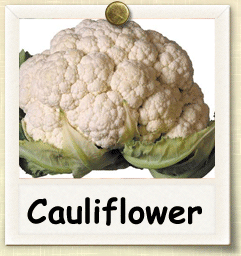|
Home > Guides > Vegetables > Cauliflower |
|
How to Grow Cauliflower | Guide to Growing Cauliflower |
|
|
|
|
| |
 |
|
Overview |
|
|
|
|
|
| |
|
| |
The most finicky and difficult of the cole (cabbage family) crops to grow, cauliflower flourishes when temperatures are moderate. Purple, orange and yellow-green colored varieties make good addition to flower gardens. |
|
| |
|
|
| |
Growing Guide
GROWING NOTES
Can tolerate light shade but will slow maturity. Light shade can be beneficial in warm weather.
Prefers well-drained, fertile soil high in organic matter, pH 6.0 to 7.5. Can tolerate slightly alkaline soil. Needs plentiful, consistent moisture.
Biennial grown as an annual.
In addition to tying heads to blanch white-headed varieties, cauliflower requires good soil, timely planting and protection from pests.
Some varieties have white stems and veins.
MAINTAINING
Most finicky of the cole (cabbage family) crops. Heads will not develop properly in hot or dry weather, so timing is crucial. Will tolerate cold as well as other cole crops in spring, but mature heads are not resistant to hard freezes.
Sow seeds indoors 4 to 6 weeks before average last spring frost. Keep soil warm (about 75 F), until germination. Then keep plants around 60 F. Provide direct sun so plants don't get leggy. When plants are 4 to 6 weeks old, transplant into garden 15 to 24 inches apart in rows 24 to 36 inches apart. Wait until soil temperature is 50 F or above and danger of frost is past before transplanting.
Larger, older transplants are more likely to bolt when exposed to cool temperatures in the garden. Transplant when plants have four or five true leaves.
Some cultivars will form small "button" heads when the weather turns warm following a 10-day stretch when high temperatures only reach the 40s F.
Direct seeding is more difficult than with other cole crops, especially in spring. For fall crops, plant seed in late-spring early summer ½ to ¾ inch deep, about 3 inches apart. Thin to final spacings. Or start transplants in late May and transplant in late June or early July.
Plants have shallow root systems. Avoid even shallow cultivation. Mulch to protect roots, reduce weed competition and conserve moisture.
To preserve the white color of the curd, use string or rubber bands to secure outside leaves over the head when it is about 2 to 3 inches in diameter. From tying to harvest may take less than a week in summer or as long as a month in fall.
Too much sun, heat or nitrogen fertilizer can cause "ricey" heads where the curd separates into small, rice-like grains.
|
|
| |
|
| |
Heirloom seeds are the gardeners choice for seed-saving from year-to-year. Learning to save seeds is easy and fun with these books. Before you harvest, consider which varieties you might want to save seeds from so that your harvesting practice includes plants chosen for seed saving. Be sure to check out our newest seed packs, available now from Heirloom Organics. The Super Food Garden is the most nutrient dense garden you can build and everything you need is right here in one pack. The Genesis Garden s a very popular Bible Garden collection. The Three Sisters Garden was the first example of companion planting in Native American culture. See all of our brand-new seed pack offerings in our store.
|
|
| |
|
|
| |
Harvesting Guide
HARVESTING
When the curd flower head is 2 to 3" in diameter, pull three or four large leaves over the curd and fasten with a rubber band at the tips to shade and blanch the curd. Normal blanching time is 3 to 4 days, but may take longer in the fall.
Self-blanching types do not require this type of curd covering process.
Plants started in midsummer for a fall harvest will withstand light fall frosts and develop superior quality produce with a milder flavor than those that mature in hot weather. Light frosts will control insect pests allowing for fewer insect problems upon harvest.
Cauliflower should be harvested while the curd is still firm. When it is over-ripe, it becomes grainy or "ricey." When pulling off the curd, don't pull off all of the leaves - leave a row of leaves around the curd to prolong storage quality.
SAVING SEEDS
Cauliflower heads grown for seed should not be trimmed for consumption. If small amounts of seeds are wanted, allow individual pods to dry to a light brown color before picking and opening by hand. Lower pods dry first followed by those progressively higher on the plant. For larger amounts of seeds pull entire plant after a majority of pods have dried. Green pods rarely produce viable seeds even if allowed to dry after the plant is pulled.
|
|
| |
|
|
|
| |
|
|
|
|
|
| Click the packs below to see some of our other wonderful products |
|
|
|
|
|
|
|